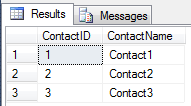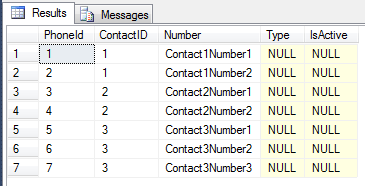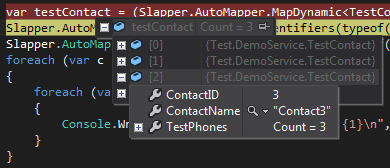原文链接: https://stackoverflow.com/questions/9350467/how-do-i-write-one-to-many-query-in-dapper-net
This post shows how to query a highly normalised SQL database, and map the result into a set of highly nested C# POCO objects.
Ingredients:
The insight that allowed me to solve this problem is to separate the MicroORM from mapping the result back to the POCO Entities. Thus, we use two separate libraries:
Essentially, we use Dapper to query the database, then use Slapper.Automapper to map the result straight into our POCOs.
List<MyClass1> which in turn contains List<MySubClass2>, etc).inner joins to return flat results is much easier than creating multiple select statements, with stitching on the client side.inner join (which brings back duplicates), we should instead use multiple select statements and stitch everything back together on the client side (see the other answers on this page).In my tests, Slapper.Automapper added a small overhead to the results returned by Dapper, which meant that it was still 10x faster than Entity Framework, and the combination is still pretty darn close to the theoretical maximum speed SQL + C# is capable of.
In most practical cases, most of the overhead would be in a less-than-optimum SQL query, and not with some mapping of the results on the C# side.
Total number of iterations: 1000
Dapper by itself: 1.889 milliseconds per query, using 3 lines of code to return the dynamic.Dapper + Slapper.Automapper: 2.463 milliseconds per query, using an additional 3 lines of code for the query + mapping from dynamic to POCO Entities.In this example, we have list of Contacts, and each Contact can have one or more phone numbers.
public class TestContact
{
public int ContactID { get; set; }
public string ContactName { get; set; }
public List<TestPhone> TestPhones { get; set; }
}
public class TestPhone
{
public int PhoneId { get; set; }
public int ContactID { get; set; } // foreign key
public string Number { get; set; }
}
TestContact
TestPhoneNote that this table has a foreign key ContactID which refers to the TestContact table (this corresponds to the List<TestPhone> in the POCO above).

In our SQL query, we use as many JOIN statements as we need to get all of the data we need, in a flat, denormalized form. Yes, this might produce duplicates in the output, but these duplicates will be eliminated automatically when we use Slapper.Automapper to automatically map the result of this query straight into our POCO object map.
USE [MyDatabase]; SELECT tc.[ContactID] as ContactID ,tc.[ContactName] as ContactName ,tp.[PhoneId] AS TestPhones_PhoneId ,tp.[ContactId] AS TestPhones_ContactId ,tp.[Number] AS TestPhones_Number FROM TestContact tc INNER JOIN TestPhone tp ON tc.ContactId = tp.ContactId

const string sql = @"SELECT tc.[ContactID] as ContactID ,tc.[ContactName] as ContactName ,tp.[PhoneId] AS TestPhones_PhoneId ,tp.[ContactId] AS TestPhones_ContactId ,tp.[Number] AS TestPhones_Number FROM TestContact tc INNER JOIN TestPhone tp ON tc.ContactId = tp.ContactId"; string connectionString = // -- Insert SQL connection string here. using (var conn = new SqlConnection(connectionString)) { conn.Open(); // Can set default database here with conn.ChangeDatabase(...) { // Step 1: Use Dapper to return the flat result as a Dynamic. dynamic test = conn.Query<dynamic>(sql); // Step 2: Use Slapper.Automapper for mapping to the POCO Entities. // - IMPORTANT: Let Slapper.Automapper know how to do the mapping; // let it know the primary key for each POCO. // - Must also use underscore notation ("_") to name parameters in the SQL query; // see Slapper.Automapper docs. Slapper.AutoMapper.Configuration.AddIdentifiers(typeof(TestContact), new List<string> { "ContactID" }); Slapper.AutoMapper.Configuration.AddIdentifiers(typeof(TestPhone), new List<string> { "PhoneID" }); var testContact = (Slapper.AutoMapper.MapDynamic<TestContact>(test) as IEnumerable<TestContact>).ToList(); foreach (var c in testContact) { foreach (var p in c.TestPhones) { Console.Write("ContactName: {0}: Phone: {1}\n", c.ContactName, p.Number); } } } }

Looking in Visual Studio, We can see that Slapper.Automapper has properly populated our POCO Entities, i.e. we have a List<TestContact>, and each TestContact has a List<TestPhone>.

Both Dapper and Slapper.Automapper cache everything internally for speed. If you run into memory issues (very unlikely), ensure that you occasionally clear the cache for both of them.
Ensure that you name the columns coming back, using the underscore (_) notation to give Slapper.Automapper clues on how to map the result into the POCO Entities.
Ensure that you give Slapper.Automapper clues on the primary key for each POCO Entity (see the lines Slapper.AutoMapper.Configuration.AddIdentifiers). You can also use Attributes on the POCO for this. If you skip this step, then it could go wrong (in theory), as Slapper.Automapper would not know how to do the mapping properly.
How do I write one to many query in Dapper.Net?
原文:https://www.cnblogs.com/bisslot/p/14791200.html